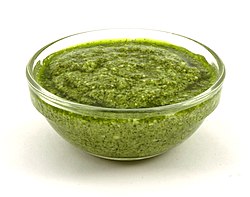Pesto sauce

Basil pesto
|
|
| Alternative names | Pesto alla genovese |
|---|---|
| Course | Sauce |
| Place of origin | Italy |
| Region or state | Genoa |
| Main ingredients | basil, garlic, oil, grated hard cheese, pine nuts |
| |
|
Pesto (Italian: [ˈpesto]; Ligurian: [ˈpestu]) or, in extenso, pesto alla genovese (Italian pronunciation: [ˈpesto alla dʒenoˈveːze; -eːse]), is a sauce originating in Genoa, the capital city of Liguria, Italy. It traditionally consists of crushed garlic, European pine nuts, coarse salt, basil leaves, Parmigiano-Reggiano (Parmesan cheese) and pecorino sardo (cheese made from sheep's milk), all blended with olive oil.
The name is the past participle of the Genoese verb pestâ (Italian: pestare), which means to pound, to crush, in reference to the original method of preparation: according to tradition, the ingredients are "crushed" or ground in a marble mortar through a circular motion of a wooden pestle. This same Latin root, through Old French, also gave rise to the English noun pestle.
Strictly speaking, pesto is a generic term for anything that is made by pounding; that is why the word is used for several pestos in Italy. Nonetheless, pesto alla genovese ("Genoese pesto") remains the most popular pesto in Italy and the rest of the world.
Pesto is thought to have two predecessors in ancient times, going back as far as the Roman age. The ancient Romans used to eat a similar paste called moretum, which was made by crushing garlic, salt, cheese, herbs, olive oil and vinegar together: the use of this paste in the Roman cuisine is even mentioned in the Appendix Vergiliana, an ancient collection of poems where the author dwells on the details about the preparation of moretum. During the Middle Ages, a popular sauce in the Genoan cuisine was agliata, which was basically a mash of garlic and walnuts, as garlic was a staple in the nutrition of Ligurians, especially for the seafarers.
...
Wikipedia
